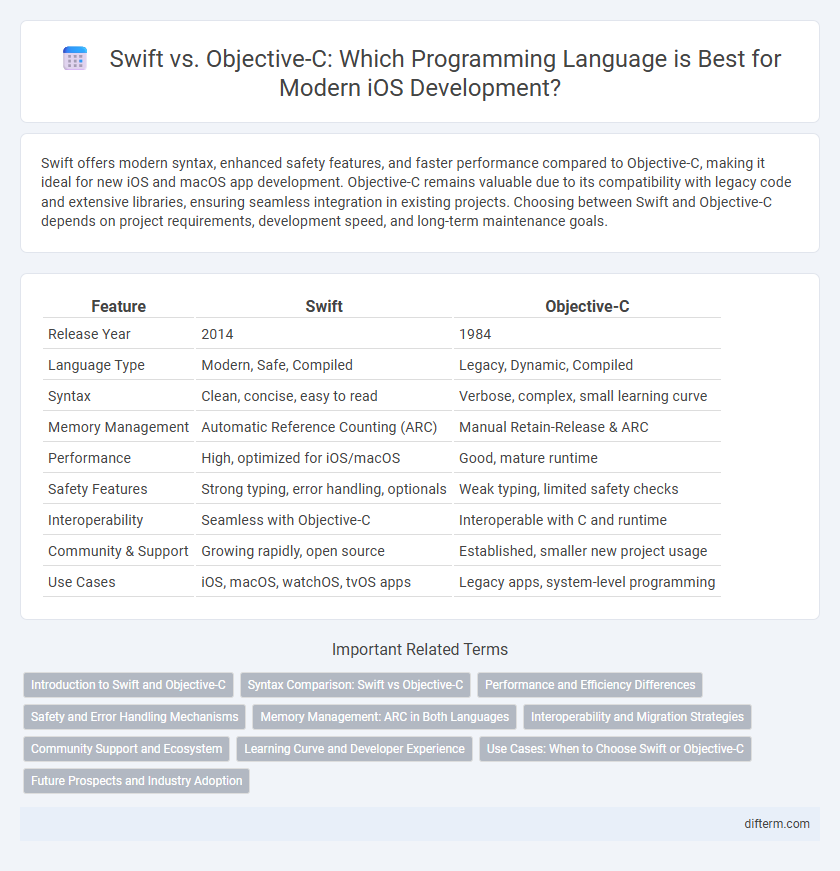Swift offers modern syntax, enhanced safety features, and faster performance compared to Objective-C, making it ideal for new iOS and macOS app development. Objective-C remains valuable due to its compatibility with legacy code and extensive libraries, ensuring seamless integration in existing projects. Choosing between Swift and Objective-C depends on project requirements, development speed, and long-term maintenance goals.
Table of Comparison
| Feature | Swift | Objective-C |
|---|---|---|
| Release Year | 2014 | 1984 |
| Language Type | Modern, Safe, Compiled | Legacy, Dynamic, Compiled |
| Syntax | Clean, concise, easy to read | Verbose, complex, small learning curve |
| Memory Management | Automatic Reference Counting (ARC) | Manual Retain-Release & ARC |
| Performance | High, optimized for iOS/macOS | Good, mature runtime |
| Safety Features | Strong typing, error handling, optionals | Weak typing, limited safety checks |
| Interoperability | Seamless with Objective-C | Interoperable with C and runtime |
| Community & Support | Growing rapidly, open source | Established, smaller new project usage |
| Use Cases | iOS, macOS, watchOS, tvOS apps | Legacy apps, system-level programming |
Introduction to Swift and Objective-C
Swift, introduced by Apple in 2014, is a modern programming language designed for iOS and macOS development, emphasizing safety, performance, and syntax simplicity. Objective-C, dating back to the 1980s, remains integral to Apple's ecosystem, known for its dynamic runtime and extensive legacy codebase. Swift offers improved memory management and faster execution compared to Objective-C, making it the preferred choice for new app development.
Syntax Comparison: Swift vs Objective-C
Swift's syntax is concise and modern, designed for readability and ease of use, featuring type inference and less boilerplate code compared to Objective-C. Objective-C relies on verbose, bracketed message calls and manual memory management, which can increase complexity for developers. Swift's clean syntax and safety features such as optionals and type safety provide significant advantages in code maintainability and error reduction over Objective-C.
Performance and Efficiency Differences
Swift offers faster performance and improved memory management compared to Objective-C due to its modern syntax and built-in safety features like automatic reference counting (ARC). Objective-C relies on dynamic runtime, which can introduce overhead, making Swift more efficient for computationally intensive tasks. Benchmarks show Swift code executes up to 2-3 times faster than equivalent Objective-C implementations in many use cases.
Safety and Error Handling Mechanisms
Swift provides enhanced safety with features like optionals, type inference, and strict compile-time checks, reducing common programming errors. Unlike Objective-C's dynamic typing and runtime error detection, Swift enforces safer code execution through strong static typing and built-in error handling using try-catch blocks and throwable functions. These mechanisms significantly decrease runtime crashes and improve overall application stability in Swift compared to Objective-C.
Memory Management: ARC in Both Languages
Swift and Objective-C both utilize Automatic Reference Counting (ARC) for memory management, enhancing performance by automatically managing object lifetimes. Swift's ARC is more optimized and integrated with its strong type system, reducing memory leaks and improving safety compared to Objective-C's ARC. Developers benefit from Swift's modern syntax and tighter ARC enforcement, which simplifies tracking and releasing memory in complex applications.
Interoperability and Migration Strategies
Swift and Objective-C offer robust interoperability, enabling developers to seamlessly integrate Swift modules into existing Objective-C codebases and vice versa. Migration strategies often involve incrementally rewriting legacy Objective-C code into Swift, leveraging bridging headers to facilitate smooth communication between the two languages. This approach minimizes risk while modernizing applications, ensuring compatibility with Apple's evolving ecosystem and enhancing code maintainability.
Community Support and Ecosystem
Swift boasts a rapidly expanding community with extensive contributions to open-source projects, making it a preferred choice for modern iOS and macOS development. Objective-C, while older, benefits from a mature ecosystem with a wealth of legacy libraries and frameworks, ensuring compatibility with established Apple technologies. Both languages integrate seamlessly with Apple's development tools, but Swift's active community accelerates innovation and library creation.
Learning Curve and Developer Experience
Swift offers a gentler learning curve for new developers due to its modern syntax and safety features, reducing common coding errors and enhancing readability. Objective-C, with its legacy status and more complex syntax, presents a steeper learning curve but provides deep integration with existing Apple ecosystems and mature tooling. Developer experience in Swift is often more efficient, thanks to real-time error handling and playgrounds, while Objective-C benefits from stability and extensive community support accrued over decades.
Use Cases: When to Choose Swift or Objective-C
Swift excels in developing modern iOS and macOS applications requiring safety, speed, and concise syntax, making it ideal for new projects and startups prioritizing rapid development and maintainability. Objective-C remains relevant for maintaining legacy codebases, integrating with older libraries, and projects demanding mature runtime features or dynamic method resolution. Choosing Swift or Objective-C depends on factors like project age, team expertise, and the need for cutting-edge language features versus stability and compatibility with existing Objective-C code.
Future Prospects and Industry Adoption
Swift's modern syntax, safety features, and active open-source community drive its rapid adoption in iOS and macOS development, positioning it as the preferred language for future projects. Objective-C maintains a significant presence due to legacy codebases and existing enterprise applications but sees limited growth compared to Swift. Industry trends indicate a shift toward Swift for new software development, reflecting its enhanced performance and easy integration with Apple's evolving technology stack.
Swift vs Objective-C Infographic

 difterm.com
difterm.com